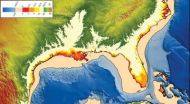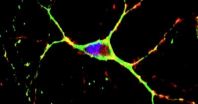(Press-News.org) Boulder, CO, USA – In the evolutionary long run, small critters tend to evolve into bigger beasts -- at least according to the idea attributed to paleontologist Edward Cope, now known as Cope's Rule. Using the latest advanced statistical modeling methods, a new test of this rule as it applies dinosaurs shows that Cope was right -- sometimes.
"For a long time, dinosaurs were thought to be the example of Cope's Rule," says Gene Hunt, curator in the Department of Paleobiology at the National Museum of Natural History (NMNH) in Washington, D.C. Other groups, particularly mammals, also provide plenty of classic examples of the rule, Hunt says.
To see if Cope's rule really applies to dinosaurs, Hunt and colleagues Richard FitzJohn of the University of British Columbia and Matthew Carrano of the NMNH used dinosaur thigh bones (aka femurs) as proxies for animal size. They then used that femur data in their statistical model to look for two things: directional trends in size over time and whether there were any detectable upper limits for body size.
"What we did then was explore how constant a rule is this Cope's Rule trend within dinosaurs," said Hunt. They looked across the "family tree" of dinosaurs and found that some groups, or clades, of dinosaurs do indeed trend larger over time, following Cope's Rule. Ceratopsids and hadrosaurs, for instance, show more increases in size than decreases over time, according to Hunt. Although birds evolved from theropod dinosaurs, the team excluded them from the study because of the evolutionary pressure birds faced to lighten up and get smaller so they could fly better.
As for the upper limits to size, the results were sometimes yes, sometimes no. The four-legged sauropods (i.e., long-necked, small-headed herbivores) and ornithopod (i.e., iguanodons, ceratopsids) clades showed no indication of upper limits to how large they could evolve. And indeed, these groups contain the largest land animals that ever lived.
Theropods, which include the famous Tyrannosaurus rex, on the other hand, did show what appears to be an upper limit on body size. This may not be particularly surprising, says Hunt, because theropods were bipedal, and there are physical limits to how massive you can get while still being able to move around on two legs.
Hunt, FitzJohn, and Carrano will be presenting the results of their study on the afternoon of Sunday, Nov. 4, at the annual meeting of The Geological Society of America in Charlotte, North Carolina, USA.
As for why Cope's Rule works at all, that is not very well understood, says Hunt. "It does happen sometimes, but not always," he added. The traditional idea that somehow "bigger is better" because a bigger animal is less likely to be preyed upon is naïve, Hunt says. After all, even the biggest animals start out small enough to be preyed upon and spend a long, vulnerable, time getting gigantic.
###
WHAT: Testing Cope's Rule and the Existence of an Upper Bound for Body Size in Non-Avian Dinosaurs
WHEN: 4:15-4:30 p.m., Sunday 4 November
WHERE: Charlotte Convention Center, Room 217D
ABSTRACT: https://gsa.confex.com/gsa/2012AM/webprogram/Paper211594.html
CONTACT:
Gene Hunt
National Museum of Natural History, Smithsonian Institution
+1-202-633-1331
http://paleobiology.si.edu/staff/individuals/hunt.cfm
Find out what else is new and newsworthy by browsing the complete technical program schedule at https://gsa.confex.com/gsa/2012AM/finalprogram/.
To identify presentations in specific areas of interest, search topical sessions by discipline categories or sponsors using the drop-down menus at www.geosociety.org/meetings/2012/sessions/topical.asp, or use your browser's "find" feature to search for keywords or convener names.
Representatives of the media and public information officers from universities, government agencies, and research institutions, may participate in technical sessions, field trips, and other special events at the Annual Meeting. Eligible media personnel will receive complimentary registration and are invited to use GSA's newsroom facilities while at the meeting. Journalists and PIOs must pay for any short courses or field trips in which they wish to participate.
For information on media eligibility, go to www.geosociety.org/meetings/2012/media.htm. Media personnel may register onsite in the GSA Newsroom (room 204) at the Charlotte Convention Center. Wireless Internet access and a quiet space for interviews will be provided in the newsroom, along with beverages and light snacks throughout the day.
Newsroom Hours of Operation
Saturday, 3 Nov., 3 p.m. to 5 p.m.
Sunday, 4 Nov., through Tuesday, 6 Nov., 7:30 a.m. to 6 p.m.
Wednesday, 7 Nov., 7:30 a.m. to 5:30 p.m.
Newsroom telephone number (incoming calls): +1-704-339-6207 (starting Saturday afternoon).
Contact Christa Stratton, GSA Director of Communications & Marketing, for additional information and assistance.
www.geosociety.org/meetings/2012/
The Geological Society of America, founded in 1888, is a scientific society with more than 25,000 members from academia, government, and industry in more than 100 countries. Through its meetings, publications, and programs, GSA enhances the professional growth of its members and promotes the geosciences in the service of humankind. Headquartered in Boulder, Colorado, USA, GSA encourages cooperative research among earth, life, planetary, and social scientists, fosters public dialogue on geoscience issues, and supports all levels of earth science education.
www.geosociety.org
Were dinosaurs destined to be big? Testing Cope's rule
GSA Annual Meeting Presentation: Testing Cope's rule and the existence of an upper bound for body size in non-avian dinosaurs
2012-11-02
ELSE PRESS RELEASES FROM THIS DATE:
Study: Alcohol, drug abuse counselors don't always require total abstinence
2012-11-02
WASHINGTON – Compared to a survey conducted nearly 20 years ago, about twice the proportion of addiction counselors now find it acceptable for at least some of their patients to have a drink occasionally – either as an intermediate goal or as their final treatment goal, according to a new study published by the American Psychological Association.
The researchers surveyed 913 members of the National Association of Alcoholism and Drug Addiction Counselors from across the United States. About 50 percent of the respondents said it would be acceptable if some of their clients ...
Difficult-to-read font reduces political polarity, study finds
2012-11-02
CHAMPAIGN, lll. — Liberals and conservatives who are polarized on certain politically charged subjects become more moderate when reading political arguments in a difficult-to-read font, researchers report in a new study. Likewise, people with induced bias for or against a defendant in a mock trial are less likely to act on that bias if they have to struggle to read the evidence against him.
The new research, reported in the Journal of Experimental Social Psychology, is one of two studies to show that subtle manipulations that affect how people take in information can ...
Abstract thinking can make you more politically moderate
2012-11-02
CHAMPAIGN, lll. — Partisans beware! Some of your most cherished political attitudes may be malleable! Researchers report that simply answering three "why" questions on an innocuous topic leads people to be more moderate in their views on an otherwise polarizing political issue.
The research, described in the journal Social Psychological and Personality Science, explored attitudes toward what some people refer to as the ground zero mosque, an Islamic community center and mosque built two blocks from the site of the former World Trade Center in New York City. When the Islamic ...
Researchers 'watch' antibiotics attack tuberculosis bacteria inside cells
2012-11-02
NEW YORK (Nov. 1, 2012) -- Weill Cornell Medical College researchers report that mass spectrometry, a tool currently used to detect and measure proteins and lipids, can also now allow biologists to "see" for the first time exactly how drugs work inside living cells to kill infectious microbes. As a result, scientists may be able to improve existing antibiotics and design new, smarter ones to fight deadly infections, such as tuberculosis. The new study was published in today's early online edition of Science.
"The development of antibiotics has been stalled for several ...
Why seas are rising ahead of predictions
2012-11-02
Boulder, CO, USA – Sea levels are rising faster than expected from global warming, and University of Colorado geologist Bill Hay has a good idea why. The last official IPCC report in 2007 projected a global sea level rise between 0.2 and 0.5 meters by the year 2100. But current sea-level rise measurements meet or exceed the high end of that range and suggest a rise of one meter or more by the end of the century.
"What's missing from the models used to forecast sea-level rise are critical feedbacks that speed everything up," says Hay. He will be presenting some of these ...
Bird tree tells new tale of evolution
2012-11-02
Contact:
Arne Mooers, 778.782.3979, amooers@sfu.ca
Carol Thorbes, PAMR, 778.782.3035, cthorbes@sfu.ca END ...
Berkeley Lab scientists help develop promising therapy for Huntington's disease
2012-11-02
There's new hope in the fight against Huntington's disease. A group of researchers that includes scientists from the U.S. Department of Energy's Lawrence Berkeley National Laboratory (Berkeley Lab) have designed a compound that suppresses symptoms of the devastating disease in mice.
The compound is a synthetic antioxidant that targets mitochondria, an organelle within cells that serves as a cell's power plant. Oxidative damage to mitochondria is implicated in many neurodegenerative diseases including Alzheimer's, Parkinson's, and Huntington's.
The scientists administered ...
The ins and outs of in-groups and out-groups
2012-11-02
We humans organize ourselves in myriad kinds of social groups, from scout troops and sports teams to networks of friends, colleagues, or classmates. But how do these social groups work? How do we decide whom to trust and whom to follow? And how do we deal with people that don't seem to fit the norms of our social groups?
New research published in Psychological Science, a journal of the Association for Psychological Science, explores these issues by examining various facets of social perception and behavior.
The Herding Hormone: Oxytocin Stimulates In-Group Conformity
Mirre ...
Bigger human genome pool uncovers rarer variants
2012-11-02
Contact:
Iman Hajirasouliha, 778.782.7040, 604.418.4834 (cell), imanh@sfu.ca
Carol Thorbes, PAMR, 778.782.3035, cthorbes@sfu.ca
Flickr: http://at.sfu.ca/skirFz END ...
UC Davis scientists identify new target for lung cancer treatment
2012-11-02
(SACRAMENTO, Calif.) — A team of UC Davis investigators has discovered a protein on the surface of lung cancer cells that could prove to be an important new target for anti-cancer therapy. A series of experiments in mice with lung cancer showed that specific targeting of the protein with monoclonal antibodies reduced the size of tumors, lowered the occurrence of metastases and substantially lengthened survival time. The findings will be published in the November issue of Cancer Research.
"Lung cancer continues to be one of the biggest killers in the United States, and ...
LAST 30 PRESS RELEASES:
NASA’s Webb telescope finds bizarre atmosphere on a lemon-shaped exoplanet
The gut bacteria that put the brakes on weight gain in mice
Exploring how patients feel about AI transcription
Category ‘6’ tropical cyclone hot spots are growing
Video: Drivers struggle to multitask when using dashboard touch screens, study finds
SLU research shows surge in alcohol-related liver disease driving ‘deaths of despair’
Rising heat reshapes how microbes break down microplastics, new review finds
Roots reveal a hidden carbon pathway in maize plants
Membrane magic: FAMU-FSU researchers repurpose fuel cells membranes for new applications
UN Member States pledge to increase access to diagnosis and inhaled medicines for the 480 million people living with COPD
Combination therapy shows potential to treat pediatric brain cancer ATRT
Study links seabird nesting to shark turf wars in Hawai‘i
Legal sports betting linked to sharp increases in violent crime, study finds
Breakthrough AI from NYUAD speeds up discovery of life-supporting microbes
New Eva Mayr-Stihl Foundation funding initiative boosts research at University of Freiburg on adaptation of forests to global change
The perfect plastic? Plant-based, fully saltwater degradable, zero microplastics
Bias in data may be blocking AI’s potential to combat antibiotic resistance
Article-level metrics would provide more recognition to most researchers than journal-level metrics
Satiety’s little helper: Protein that supports appetite regulating protein identified
UF dives deep into predicting storm damage with computer models
A stormy ocean voyage yields insights on the global carbon cycle
Scientists identify first non-coding gene that controls cell size
Demonstration of altermagnetism in RuO₂ thin films -- A new magnetic material for the AI era
Penn researchers awarded $25M to conduct trial using smartphones to fight heart disease
PCORI awards funding for new patient-centered healthcare research
Exploring the origins of the universe: 145 low-noise amplifiers complete ALMA telescopes
Empress cicada wings help illuminate molecular structure
Using sound waves to detect helium
Time burden in patients with metastatic breast and ovarian cancer from clinic and home demands
Researchers discover bias in AI models that analyze pathology samples
[Press-News.org] Were dinosaurs destined to be big? Testing Cope's ruleGSA Annual Meeting Presentation: Testing Cope's rule and the existence of an upper bound for body size in non-avian dinosaurs



